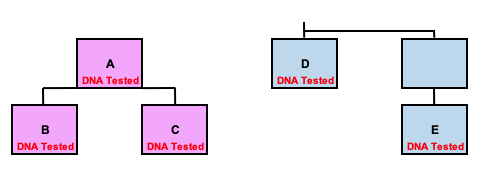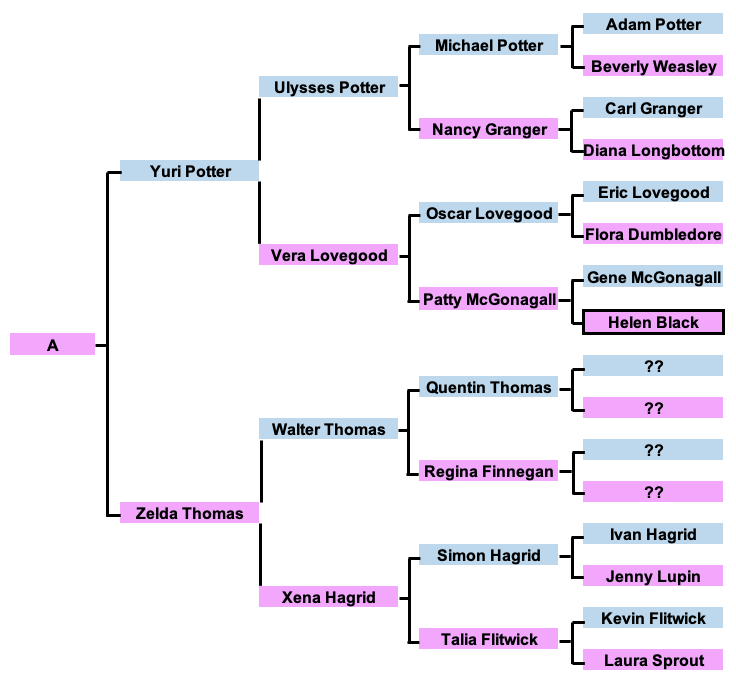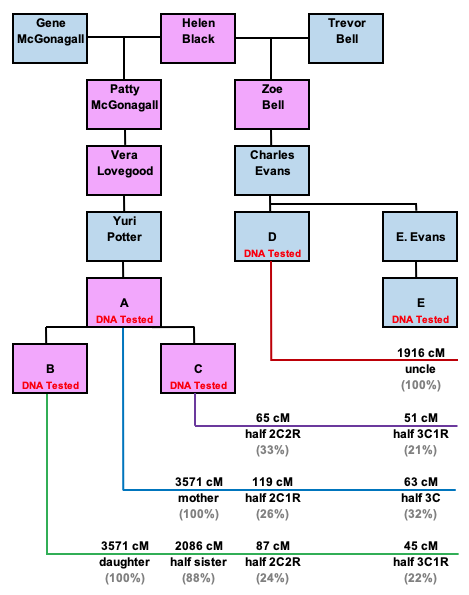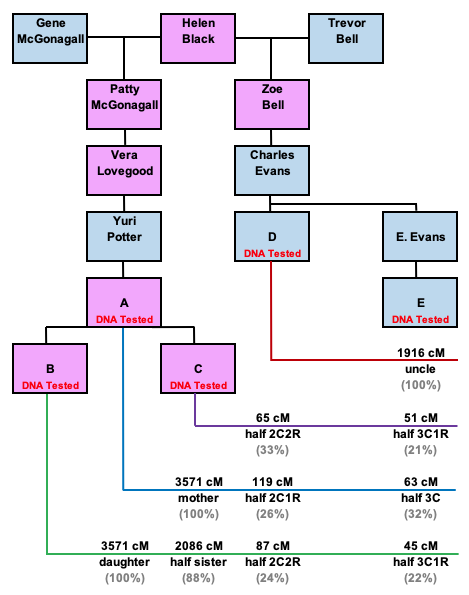Over the past few weeks, I’ve been describing a problem I’ve been working on: using DNA to learn about the ancestry of someone (“Bob”) who was uncertain of the identity of his biological father. After examining what the paper records suggested for Bob’s maternal and paternal ancestors, I looked at Bob’s top DNA matches. Some of the matches appeared to be related through Bob’s maternal side, but none appeared to share ancestry with his legal father. This supported the theory that Bob’s father was not his biological father, and provided some leads about Bob’s actual paternal ancestry.
Five of Bob’s top matches had results on GEDmatch. Based on amounts of DNA shared and trees provided, three of the testers appeared to be a mother, “A,” and her two daughters, “B,” and “C” (half-sisters). The other two appeared to be an uncle, “D,” and nephew, “E.” See Figure 1. Since A, B, and C had results at MyHeritage, and D and E had results at FamilyTreeDNA, using GEDmatch was very helpful in bringing their results together for comparisons that could not have been done otherwise.

I was able to find a couple of online trees, showing at least some of the ancestors for matches A and D. The trees I found, though, did not show any common ancestors, so I had to build the trees further myself. According to GEDmatch, match A and match D share 119.2 centimorgans (cM) of DNA, which is likely to correspond to a relationship in the range of a half second cousin, a second cousin once removed, or a third cousin.1 Since third cousins would share a set of second-great-grandparents, I aimed to build back the trees for A and D to that level.


Figure 2 shows the ancestors for Match A and Match D. A and D appear to share one ancestor back to the second-great-grandparent level, with A as the second-great-granddaughter of Helen Black and Gene McGonagall, and D as the great-grandson of Helen Black and Trevor Bell. Records are consistent with the same Helen Black marrying Trevor Bell, having children including Zoe Bell, marrying Gene McGonagall after Trevor’s death, and having children including Patty McGonagall. This would make A the half second cousin once removed, of D (consistent with predictions, given the amount of DNA they share).2
To check the relationships of these matches relative to each other in the context of this common ancestry, I put all five into a tree with Helen Black as the most recent common ancestor (MRCA) and visualized their amounts of shared DNA using The McGuire Method – see Figure 3 below.

The McGuire chart shows that this family structure makes sense for all five matches given the amount of DNA shared. Every pair of matches shares an appropriate amount of DNA given the predicted relationships (all have relationship probabilities above 20% according to The Shared cM Tool).
Therefore, it appears that these five DNA matches and Bob all share Helen Black as a common ancestor. Next step: examine the descendants of Helen Black (descendants of each of her seven children from two different husbands) to see who could have possibly been Bob’s father.
All Posts in the Series:
- DNA & A Question of Paternity: Part 1 – Introduction
- DNA & A Question of Paternity: Part 2 – Starting with what we knew
- DNA & A Question of Paternity: Part 3 – Identifying Autosomal Matches
- DNA & A Question of Paternity: Part 4 – Building a New Family Tree
- DNA & A Question of Paternity: Part 5 – Bringing together Autosomal & Y-DNA Results
- DNA & A Question of Paternity: Part 6 – Statistically testing hypothetical relationships
- DNA & A Question of Paternity: Part 7 – Bringing the evidence together
- DNA & A Question of Paternity: Part 8 – Analysis with a new match
1. Relationship estimates from “The Shared cM Project 3.0 tool v4,” DNA Painter(https://dnapainter.com/tools/sharedcmv4: accessed 26 March 2019), for a total of 119 cM.
2. Relationship estimates from “The Shared cM Project 3.0 tool v4,” DNA Painter(https://dnapainter.com/tools/sharedcmv4: accessed 26 March 2019), for a total of 119 cM.
